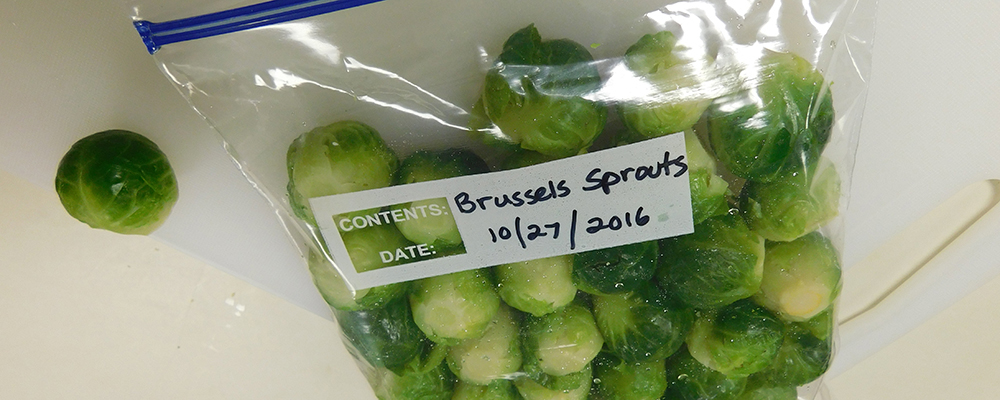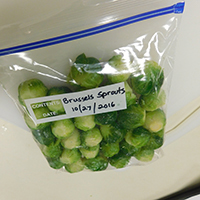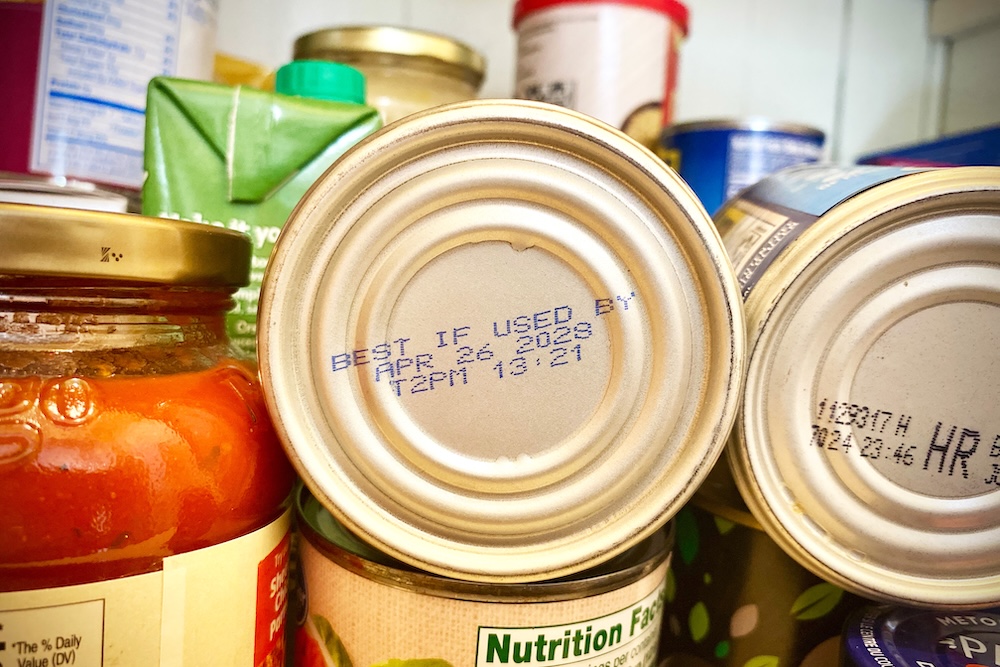Freezing is one of the easiest and most convenient ways to extend the shelf life of fresh fruits and vegetables.
Properly frozen fruits and vegetables will retain much of their fresh flavor and nutritive value. Texture, however, may be somewhat softer after thawing than fresh versions.
The extreme cold stops growth of microorganisms and slows down changes that cause spoilage and affect quality in food, but will not sterilize food, said Elizabeth Andress, a faculty member in the UGA College of Family and Consumer Sciences.
“It’s important to use good sanitary practices when preparing and packaging food for the freezer,” said Andress, director of the National Center for Home Food Preservation. “When thawing the food, it’s important to use good temperature control to prevent the surviving bacteria and molds from becoming a problem on warming food. Fortunately, most vegetables can be cooked right from the frozen state. If you need to thaw foods before using them, inside the cold refrigerator is the safest way to do so.”
For additional tips on thawing and using frozen foods, visit nchfp.uga.edu/how/freeze/thawing.html
Package the food for best protection in the freezer
Plastic bags are the most frequently used packaging material for freezing food items, although you can also use plastic freezer containers or glass canning/freezing jars.
Packaging materials must be durable and leakproof, easy to seal with airtight sealing surfaces, able to protect foods from off flavors or odors and should not become brittle or crack at low temperatures.
“Don't use paper cartons, like milk boxes,” Andress said. “Many plastic containers foods are packaged in for purchase, like yogurt, dips and sour cream, do not provide characteristics for preserving quality in the freezer. Some materials may let air and moisture through them which is not good. Freezer-weight plastic bags, freezer foil and coated freezer paper are good for odd shaped foods.”
Preparing the food
Fruits should be washed and sorted before freezing. Discard those that are poor quality or not yet ripe.
Rinse the fruit under cool, running water while rubbing skins to clean them well. For fruit with firm peels, use a clean vegetable brush and scrub well. Allowing fruit to soak in water is not recommended because it will cause loss of nutrients and flavor.
“Stem, pit, peel or slice fruit as desired,” Andress said. “Prepare enough fruit for only a few packages at a time to prevent browning.”
Light-colored fruits or any that brown once cut can be put in an ascorbic acid water bath to hold them as you get your batch prepared for packaging.
“Pure ascorbic acid in a powder form is available online, in drugstores or in stores with freezing supplies or as vitamin C tablets,” Andress said. “For a bath to hold your fruit as you are cutting and trimming it, use one teaspoon dissolved in one gallon of cool, clean water.”
If you purchase vitamin C tablets, use those with as few other ingredients as possible. Crush as many as you need for 3,000 milligrams (one teaspoon) to dissolve in one gallon of water.
You can also buy commercial ascorbic acid mixtures with canning and freezing supplies; follow the directions on the label.
Use vegetables at peak flavor and texture. Whenever possible, harvest in the morning and freeze within a few hours.
Wash vegetables thoroughly in cold water and sort according to size for blanching and packing. Blanching, or scalding, vegetables in boiling water or steam for a short period of time should be done to ensure highest frozen food quality and shelf life.
“Blanching stops the action of enzymes that can cause loss of flavor, color and texture over time in the freezer,” Andress said. “Blanching time is crucial and varies with the vegetable and its size. Under-blanching stimulates the activity of enzymes and is worse than not blanching at all; over-blanching can cause loss of flavor, color, vitamins and minerals.”
Specific blanching times for vegetables can be found at nchfp.uga.edu/how/freeze.html.
Water blanching is the most widely-recommended method for blanching vegetables.
Use one gallon of water per pound of vegetables. Put the vegetables in a blanching basket or strainer and lower into vigorously boiling water.
Place a lid on the pot and start counting blanching time as soon as the water returns to a boil. If the water does not come quickly back to a boil, you are using too many vegetables at one time.
The link above provides detailed directions for freezing each type of vegetable.
As soon as blanching is complete, cool vegetables quickly to stop the cooking process by plunging the basket of vegetables immediately into a large quantity of cold water.
Cooling vegetables should take as long as blanching. Drain vegetables completely after cooling.
“You do not want to package vegetables for the freezer that still have water clinging to them, as this is not good for food texture and quality,” Andress said.
Fruit packs
There are several ways to pack fruit for freezing, such as a syrup pack, sugar pack and unsweetened dry or tray pack.
“Many fruits have better texture and flavor if packed in sugar or syrup,” Andress said. “However, sugar is not needed to preserve the fruit.”
A sugar syrup can be made by dissolving sugar in water completely and then pouring it around and over fruit in the container.
You may need to heat the water to get all of the sugar dissolved, but completely cool or even refrigerate the syrup to get it cold before using on fruit.
Use 2 3/4 cups sugar to four cups of water for most fruits. For mild flavor or very sweet fruits, use 1 3/4 cups sugar per four cups of water.
About one-half to two-thirds of a cup of syrup is needed per pint of fruit.
To make sugar packs, simply sprinkle sugar over the fruit and mix gently until the juice is drawn out and the sugar dissolved. Pack the fruit with the juices into your container or bag
“Making sure all the sugar is dissolved before freezing yields better fruit quality,” Andress said.
Tray or dry packing works best with berries and smaller fruits that give good flavor without sugar.
Larger strawberries could be cut into halves. Simply spread a single layer of washed, trimmed fruit on shallow trays and place in your freezer.
When the fruit pieces are frozen firm, promptly package and return to the freezer before they soften. These fruit pieces remain loose and any amount needed can be poured from the container and the package re-closed.
Those fruits that begin darkening as soon as cut edges are exposed to air, such as peaches, apples, pears and apricots, will benefit from some ascorbic acid being added in the package as well as using a holding bath.
Fruit can also start to darken during thawing. Ascorbic acid or purchased mixtures may also be used in syrup or mixed with dry sugar for those fruit packing methods.
Add half a teaspoon (1,500 milligrams) of pure powdered ascorbic acid to cold syrup shortly before using, stirring gently so as not to add air. To use in sugar or dry packs, dissolve in two or three tablespoons of cold water and sprinkle over fruit just before adding sugar.
Packaging and labeling
Most foods require headspace between the packed food and closure to allow for expansion as food freezes. Headspace recommendations can be found at nchfp.uga.edu/how/freeze.html.
All packaged food should be at room temperature or cooler before putting in the freezer.
“Do not overload your freezer with too much warm food at one time,” Andress said. “Quick freezing is best for frozen food quality.”
Spread the new packages around until they are frozen, then they can be stacked together if desired.
Freeze foods at 0 degrees Fahrenheit or lower. To facilitate more rapid freezing, set the temperature control at -10 degrees or lower about 24 hours in advance.
Keep your freezer at 0 degrees or lower for best food quality in storage and to obtain the expected shelf life.
“Be sure to label all foods with name of food, date and type of pack,” Andress said. “Most fruits and vegetables will remain high in quality for eight to 12 months. Longer storage will not make the food unfit for use, but may impair its quality.”
It is a good idea to post a list of the frozen foods with freezing dates near the freezer and check the packages off the list as they are removed.
For more information on freezing fruits and vegetables with directions for individual items, visit the National Center for Home Food Preservation online at nchfp.uga.edu/how/freeze.html.








